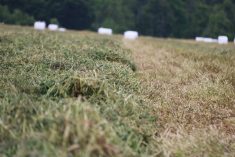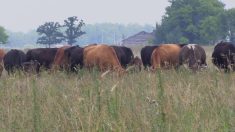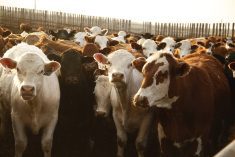The Manitoba Agricultural Services Corporation (MASC) saw a multimillion-dollar spike in forage claim payouts during the 2021 drought, the Crown corporation has reported.
MASC reported $48.3 million in forage program indemnities for 2021, over five times higher than the previous year. MASC reported $9.2 million in indemnities in 2020.
Why it matters: Higher forage insurance claim numbers should come as no surprise after 2021’s drought. But even by those expectations, the numbers are high.
David Van Deynze, chief product officer with MASC, said the corporation’s forage programs can absorb the financial hit, despite the high payouts.
Read Also

Journal pulls long-cited glyphosate study for ethics violations
The journal Regulatory Toxicology and Pharmacology has retracted a 2000 Monsanto-linked glyphosate review, drawing new scrutiny as Bayer faces mounting legal pressure.
“I think they’re bigger than anything we’ve seen before, that’s for sure, but as much as we don’t like to see poor yields and that sort of thing around, we’re sure happy that the program is responding in years when people are seeing such tough yields,” he said.
MASC generally looks at financial viability of “the program as a whole” rather than assessing the smaller programs built around specific crop types, he added.
MASC had significant funds in reserve going into the 2021 season, he said. Those reserves “definitely did take a hit” after 2021, “but we’re still coming into 2022 in a pretty good financial position,” Van Deynze said.
Those types of high payouts do impact premiums, he acknowledged, but “there’s no real danger of the forage program not responding, I would say, to the way that everyone would expect it to.”
MASC reported $4.8 million in premiums paid into forage programs last year.

Tyler Fulton, president of the Manitoba Beef Producers (MBP), noted his own surprise at the 2021 numbers, despite anticipation that forage claims would be high.
Payouts in 2021 included $8.4 million from the hay disaster benefit, triggered for the third time since the program was introduced in 2014. It was the highest payout recorded by the program. In 2018 and 2019, producers received $3.2 million and $5.2 million through the hay disaster benefit, respectively.
The program is designed to cover the extra cost of hay and feed transportation during extraordinarily difficult years and automatically triggers when at least 20 per cent of insured producers see less than half of their normal long-term hay yield. Producers then receive an extra $44 for every tonne they fall short of their normal yield.
Last year, almost 60 per cent of insured forage growers fell short of that 50 per cent yield threshold, according to MASC.
Growing conditions during the first cut were so poor, in fact, that MASC triggered the hay disaster benefit in late summer, a decision typically made the following January after the full hay season can be assessed.
“We knew early on, like everyone else, that hay was going to be in lots of trouble — and was in lots of trouble — in 2021,” Van Deynze said. “We were getting that feedback from our clients. We were getting that feedback as we sent adjusters to look at fields and all of those things.
“That decision was made early and there’s no doubt that it was the right decision because the yields were a challenge for all farmers,” he added.
Uptake
Those claim totals come with well over half of Manitoba’s estimated forage acres still uninsured.
Forage insurance uptake has been a consistent topic of conversation for years, including after another dry growing season in 2019 put pressure on Manitoba’s feed situation. At that time, the province pointed to the need to increase the poor uptake of forage insurance programs, which had hovered around a quarter or less of all forage acres through the decade before.
Producers saw the first changes from the resulting forage insurance review last year. Among the changes, MASC introduced yield cushioning to minimize the impact of disaster years on a producer’s coverage, bolstered transportation allowances and introduced an IPI for corn silage.
According to MASC data, roughly 30 per cent of forage acres were insured in Manitoba last year. The corporation has shown increasing uptake since 2018, although the increase ramped up in 2021, which the industry tied somewhat to changes, but also to the anticipation of a hard year coming into spring 2021.
The increase is “not huge leaps and bounds by any stretch, but trending in the right direction,” Van Deynze said. “We hope that continues. Again, after another tough year, we hope that producers continue to see the value in our program and, for those who haven’t participated in it, hopefully they’ll look at it and say, yeah it may be the time to get signed up.”
Fulton, meanwhile, says he expects uptake to increase again this year, although he noted that many producers still feel that the administrative burden of forage insurance is a barrier.
“I’m hoping that we’ve hit a bit of a tipping point,” he said.
“It’s never going to be for everyone, but I think that those programs have proven themselves here over the last two or three years and I’m hopeful that the uptake will continue to grow,” he added.
















